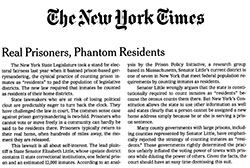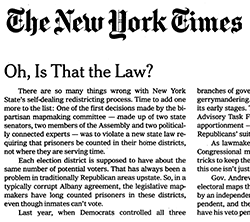News Roundup: LATFOR won’t engage in prison-based gerrymandering and Civil Rights organizations will defend NY law
Roundup of selected news coverage: LATFOR will avoid prison-based gerrymandering and civil rights orgs will defend NY law.
by Leah Sakala, August 15, 2011
The month of August has brought some exciting victories for the movement to keep prison-based gerrymandering out of New York. To summarize our recent progress, here’s a roundup of selected news coverage:
Advance #1: After expressing reluctance to comply with New York’s 2010 law that ended prison-based gerrymandering, the Legislative Task Force on Demographic Research and Reapportionment (LATFOR) definitively announced on August 4th that it will fully comply with the law by adjusting Census Bureau population data to count incarcerated individuals at their home addresses.
-
The Albany Times Union‘s coverage reported that, “One cloud has been lifted from the state’s legislative redistricting process,” explaining how LATFOR’s announcement followed pressure from civil rights advocates and legislators to count incarcerated populations in the right place.
-
A Capitol Confidential article quotes LATFOR co-chair Sen. Mike Nozzolio as saying that, “This is a bi-partisan position that the law will be complied with.”
-
The Albany Times Union and the Canandaigua Messenger Post have both run editorials praising LATFOR’s statement that it intends to follow the law. The Times Union declared,
LATFOR has done the right thing and agreed to stop the travesty of counting prisons inmates in the districts where they’re incarcerated, rather than where they otherwise would live.
-
A Gannett story reported that those glad to hear LATFOR’s announcement included civil rights advocates, legislators, and even Governor Cuomo himself:
Gov. Andrew Cuomo said Thursday that he didn’t “think it was right or fair” to count prisoners where they are incarcerated and said he stands behind the law, which was signed before he took office.
- WYNC’s The Empire and the Legislative Gazette published detailed reports on LATFOR’s announcement. The Gotham Gazette‘s recent coverage provides a helpful overview of New York’s redistricting process.
Advance #2: On August 4th, New York Supreme Court Judge Eugene Divine granted fifteen urban and rural voters from across New York State permission to intervene in Little v. LATFOR, a lawsuit challenging the New York’s law that ended prison-based gerrymandering. The Prison Policy Initiative, along with six other top civil rights organizations, will represent the fifteen voters in court.
-
The Albany Times Union‘s article explains that the judge admitted the voters into the lawsuit because they have a “genuine stake” in protecting their voting interests.
- Thomson Reuters reported:
The Brennan Center for Justice at NYU School of Law, one of the groups representing the intervenors, welcomed the decision to allow the individuals to intervene.
“We want to make sure that this law is adequately defended by people who have a stake in the matter and care to ensure that New Yorkers’ voting rights aren’t unfairly distorted,” said Wendy Weiser, a lawyer with the center.
Stay tuned for more New York updates as both LATFOR’s redistricting process and the Little v. LATFOR lawsuit proceed.








